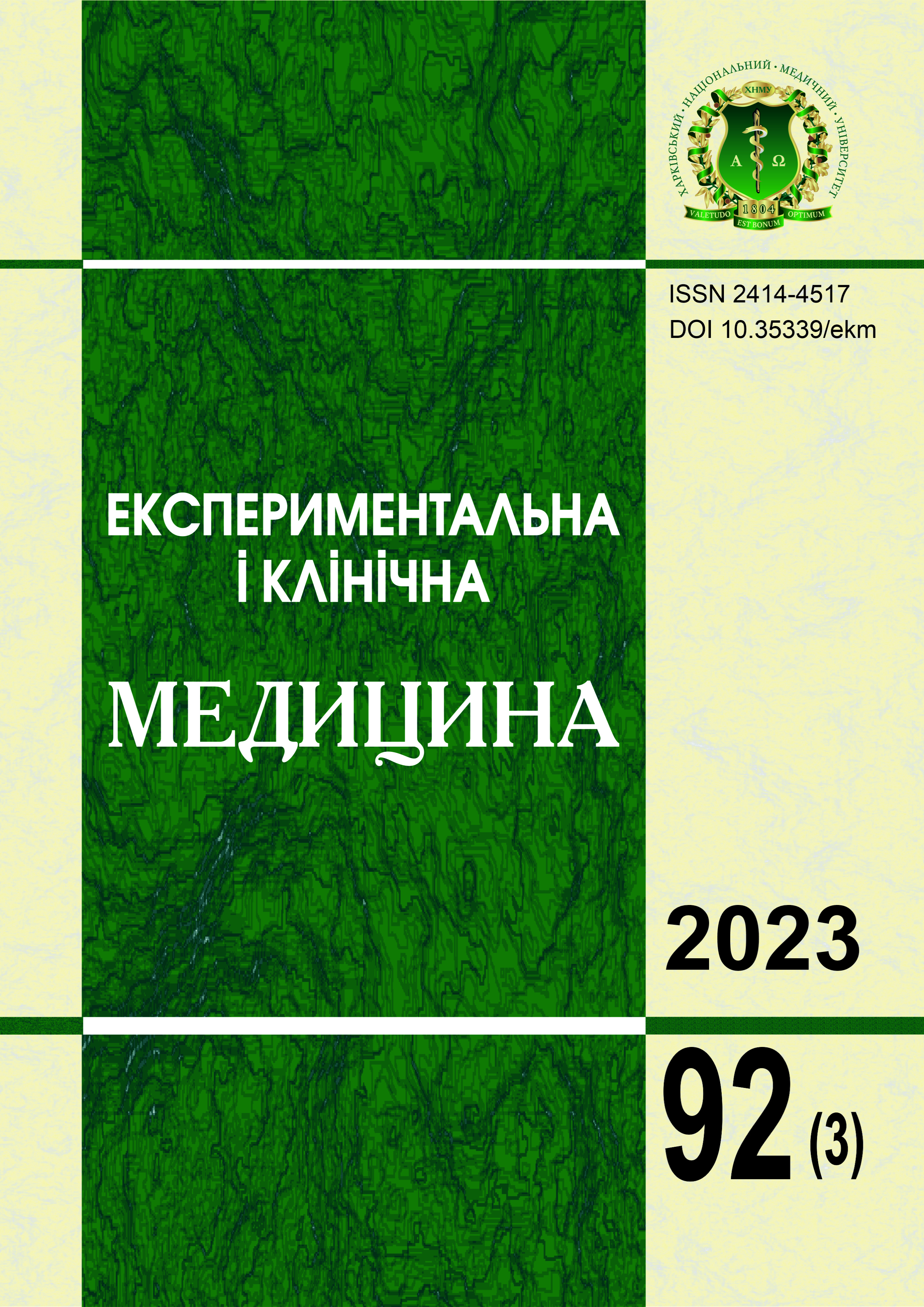Abstract
Infectious complications during endoprosthesis of large joints are one of the urgent medical and socio-economic problems of modern orthopedics and traumatology. The purpose of the study was to improve the results of treatment of periprosthetic infection in patients after total hip arthroplasty as a result of polytrauma by determining the features of the course and diagnosing it in this category of patients. To carry out the study, a retrospective analysis of 87 cases of periprosthetic infection was conducted in patients undergoing inpatient treatment at the Kyiv City Clinical Hospital of Emergency Medical Care for the period 2012–2020 and divided into observation and control groups. Іn the first group, acute postoperative periprosthetic infection (up to 4 weeks) was detected in 33 victims, which was 71.7% of the group. In the second group, this type of periprosthetic infection was detected in 23 victims, which was 56.1% of the group. Late chronic infection (from 4 weeks to 1 year) among the victims of the first group was found in 10 patients, which was 21.7% of the group. In the second group, there were 11 patients with late periprosthetic infection, which was 24.4% of the group. All patients participating in the study were divided into observation and control groups. Periprosthetic infection after total hip arthroplasty in polytrauma victims develops more often in the early stages, up to 4 weeks. In addition to gram-positive cocci, the causes of periprosthetic infection are often gram-negative enterobacteria, which indicates the prevalence of the endogenous route of infection in this category of patients. Among the etiological factors of periprosthetic infection after total hip arthroplasty in polytrauma victims, Acinetobacter spp. is quite often found, which is a consequence of long-term use of invasive methods of treatment and monitoring performed on the patient during the treatment of traumatic injuries.
Keywords: large joints, arthroplasty, microorganisms, complications, multiple trauma.
References
Parvizi J, Gehrke T, Chen AF. Proceedings of the International Consensus Meeting on Periprosthetic Joint Infection Chairmen. Bone Joint J. 2013;95-B(11):1450-2. DOI: 10.1302/0301-620X.95B11.33135. PMID: 24151261
Kurtz SM, Lau E, Watson H, Schmier JK, Parvizi J. Economic burden of periprosthetic joint infection in the United States. J Arthroplasty. 2012;27(8 Suppl):61-5.e1. DOI: 10.1016/j.arth.2012.02.022. PMID: 22554729.
Abdelaziz H, Rademacher K, Suero EM, Gehrke T, Lausmann C, Salber J, et al. The 2018 International Consensus Meeting Minor Criteria for Chronic Hip and Knee Periprosthetic Joint Infection: Validation from a Single Center. J Arthroplasty. 2020;35(8):2200-3. DOI: 10.1016/j.arth.2020.03.014. PMID: 32247671.
Villa JM, Pannu TS, Piuzzi N, Riesgo AM, Higuera CA. Evolution of Diagnostic Definitions for Periprosthetic Joint Infection in Total Hip and Knee Arthroplasty. J Arthroplasty. 2020;35(3S):S9-13. DOI: 10.1016/j.arth.2019.10.032. PMID: 32046836.
Holzmann T, Schneider-Brachert W. Mikrobiologische Diagnostik periprothetischer Gelenkinfektionen [Microbiological diagnosis of periprosthetic joint infections]. Orthopade. 2015;44(5):344-8. DOI: 10.1007/s00132-015-3087-y. PMID: 25754927. [In German.].
Fink B, Sevelda F. Diagnosis of Periprosthetic Joint Infection of Shoulder Arthroplasties. Z Orthop Unfall [Journal of Orthopedics and Trauma Surgery]. 2017;155(6):655-60. DOI: 10.1055/s-0043-112247. PMID: 28701012. [In German].
Henderson RA, Austin MS. Management of Periprosthetic Joint Infection: The More We Learn, the Less We Know. J. Arthroplasty 2017;32(7):2056-9. DOI: 10.1016/j.arth.2017.02.023. PMID: 28318868.
Renz N, Cabric S, Janz V, Trampuz A. Sonikation in der Diagnostik periprothetischer Infektionen: Stellenwert und praktische Umsetzung [Sonication in the diagnosis of periprosthetic infections: Significance and practical implementation]. Orthopade. 2015;44(12):942-5. DOI: 10.1007/s00132-015-3192-y. PMID: 26572134. [In German].
Kini SG, Gabr A, Das R, Sukeik M, Haddad FS. Two-stage Revision for Periprosthetic Hip and Knee Joint Infections. Open Orthop J. 2016;10:579-88. DOI: 10.2174/1874325001610010579. PMID: 28144371;
McNally M, Sigmund I, Hotchen A, Sousa R. Making the diagnosis in prosthetic joint infection: a European view. EFORT Open Rev. 2023;8(5):253-63. DOI: 10.1530/EOR-23-0044. PMID: 37158373.
Kildow BJ, Della-Valle CJ, Springer BD. Single vs 2-Stage Revision for the Treatment of Periprosthetic Joint Infection. J Arthroplasty. 2020;35(3S):S24-30. DOI: 10.1016/j.arth.2019.10.051. PMID: 32046827.
Janz V, Wassilew GI, Hasart O, Matziolis G, Tohtz S, Perka C. Evaluation of sonicate fluid cultures in comparison to histological analysis of the periprosthetic membrane for the detection of periprosthetic joint infection. Int Orthop. 2013;37(5):931-6. DOI: 10.1007/s00264-013-1853-1. PMID: 23525549.

This work is licensed under a Creative Commons Attribution-NonCommercial-ShareAlike 4.0 International License.

